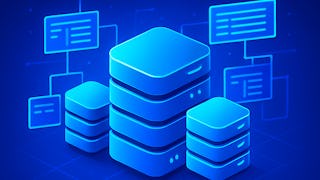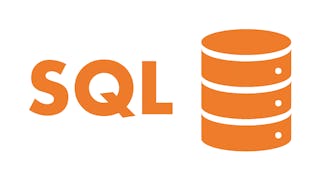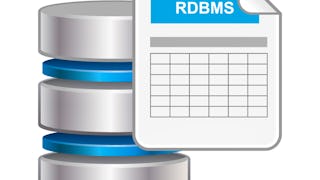In today's data-driven world, the ability to work with relational databases is an essential skill for professionals in various fields. This course is designed to equip you with the knowledge and practical skills needed to become proficient in database management and application development. Whether you are pursuing a career as a database administrator, software developer, or data analyst, this course provides you with a strong foundation to excel in your chosen field.
通过 Coursera Plus 解锁访问 10,000 多门课程。开始 7 天免费试用。


您将学到什么
Implement relational database and usage of indexes, views, triggers, temporary tables, functions, and stored procedures.
Develop database-driven applications using programming languages, such as Java, Python or C/C++ and frameworks.
Describe transaction and concurrency control concepts in relational databases.
您将获得的技能
要了解的详细信息

添加到您的领英档案
13 项作业
了解顶级公司的员工如何掌握热门技能

积累特定领域的专业知识
- 向行业专家学习新概念
- 获得对主题或工具的基础理解
- 通过实践项目培养工作相关技能
- 获得可共享的职业证书

该课程共有7个模块
Welcome to Relational Database Implementation and Applications! In Module 1 of this course, you'll delve into the fundamental aspects of building relational databases. You'll learn about implementing indexes, views, triggers, functions, and stored procedures in relational databases. We'll highlight the significance of these elements in databases and how they enhance query performance. You'll explore the creation of both simple and complex views, understanding how they offer data abstraction benefits and the versatility of managing data through views. Additionally, you'll gain experience in creating and optimizing database operations using user-defined functions, triggers, and stored procedures in SQL, thus acquiring comprehensive knowledge of accurate business logic implementation and performance optimization techniques.
涵盖的内容
5个视频10篇阅读材料2个作业1个讨论话题1个非评分实验室
Module 2 of this course offers an immersive exploration of the powerful world of SQL window functions and OLAP (Online Analytical Processing) concepts. You will learn about the definition and benefits of window functions, gaining proficiency in advanced applications such as RANK(), DENSE_RANK(), LEAD(), LAG(), NTILE(n), PERCENT_RANK(), and CUME_DIST(). Additionally, you'll develop the skills to control window function behavior using PARTITION BY and ORDER BY clauses, define custom window frames with RANGE and ROWS clauses, and design, query, and analyze OLAP datasets using ROLL-UP and DRILL-DOWN levels of aggregation.
涵盖的内容
3个视频5篇阅读材料2个作业1个非评分实验室
In Module 3 of this course, you'll learn how to develop database applications using versatile programming languages such as Java, Python, or C++. You'll discover how to establish connections to databases, perform essential CRUD (Create, Read, Update, Delete) operations, and write code that supports SQL features like triggers, functions, and stored procedures used to facilitate complex queries in relational databases. The focus will be on robust database interactions, including error and exception handling to address connection issues, query failures, and data validation, ensuring the reliability of your applications.
涵盖的内容
3个视频6篇阅读材料2个作业1个非评分实验室
Module 4 of this course provides an in-depth understanding of indexing within database systems. You'll define indexing and grasp its critical importance. Through comprehensive exploration, you'll differentiate between various types of indexes, including ordered and hash indexes, primary and secondary indexes, as well as multi-level and single-level indexes. Additionally, you'll delve into the structure of B+-trees, including nodes and leaves, and learn how these structures maintain balance, supporting efficient search operations. You'll also gain insight into B+-tree insertion and deletion operations.
涵盖的内容
2个视频3篇阅读材料2个作业1个非评分实验室
In Module 5, you will enter into the world of database transactions and their critical role in ensuring data consistency and integrity. You will gain a comprehensive understanding of the four ACID properties (Atomicity, Consistency, Isolation, Durability) and their significance in maintaining the reliability of transactions. Additionally, you'll explore techniques for managing concurrent access to data, including discussions on COMMIT and ROLLBACK behaviors, serial and serializable schedules, and conflict serializability tests using graph-based techniques. This module will also cover concepts like equivalent serial schedules, recoverability, and cascade-less schedules, empowering you to design and manage complex database systems with confidence and precision.
涵盖的内容
3个视频3篇阅读材料2个作业1个非评分实验室
Module 6 focuses on concurrency control in database management systems. You'll define concurrency control and understand its significance in maintaining data integrity while delving into the principles of lock-based concurrency control. This module will cover key concepts such as shared and exclusive lock types, lock modes, lock compatibility, and introduce the two-phase locking protocol with its guarantees. Additionally, you'll gain insights into how transactions acquire and release locks within this protocol, and you'll explore the concept of deadlocks and their underlying causes, equipping you with essential knowledge to manage concurrent access effectively and prevent data integrity issues in database systems.
涵盖的内容
2个视频3篇阅读材料2个作业1个非评分实验室
This module contains the summative course assessment that has been designed to evaluate your understanding of the course material and assess your ability to apply the knowledge you have acquired throughout the course.
涵盖的内容
1个作业
获得职业证书
将此证书添加到您的 LinkedIn 个人资料、简历或履历中。在社交媒体和绩效考核中分享。
攻读学位
课程 是 Illinois Tech提供的以下学位课程的一部分。如果您被录取并注册,您已完成的课程可计入您的学位学习,您的学习进度也可随之转移。
位教师


从 Data Analysis 浏览更多内容

Birla Institute of Technology & Science, Pilani
 状态:预览
状态:预览Universitat Politècnica de València
 状态:免费试用
状态:免费试用Illinois Tech
人们为什么选择 Coursera 来帮助自己实现职业发展




学生评论
29 条评论
- 5 stars
68.96%
- 4 stars
24.13%
- 3 stars
3.44%
- 2 stars
3.44%
- 1 star
0%
显示 3/29 个
已于 Oct 13, 2024审阅
Very Challenging, but quite rewarding to see the outcome (when your project functions as hoped).
常见问题
To access the course materials, assignments and to earn a Certificate, you will need to purchase the Certificate experience when you enroll in a course. You can try a Free Trial instead, or apply for Financial Aid. The course may offer 'Full Course, No Certificate' instead. This option lets you see all course materials, submit required assessments, and get a final grade. This also means that you will not be able to purchase a Certificate experience.
When you enroll in the course, you get access to all of the courses in the Specialization, and you earn a certificate when you complete the work. Your electronic Certificate will be added to your Accomplishments page - from there, you can print your Certificate or add it to your LinkedIn profile.
Yes. In select learning programs, you can apply for financial aid or a scholarship if you can’t afford the enrollment fee. If fin aid or scholarship is available for your learning program selection, you’ll find a link to apply on the description page.
更多问题
提供助学金,




